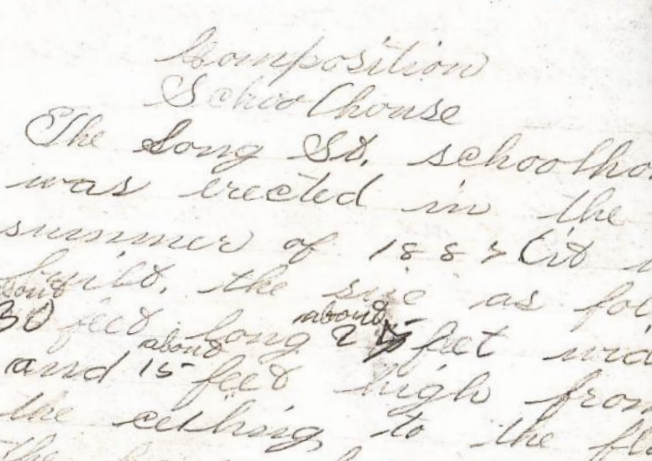A student’s view of Longstreet School
A YOUNG SCHOLAR DESCRIBES HER TYPICAL LATE 1800’S RURAL SCHOOLHOUSE
Beginning of Rhoda Weldy’s original composition at Longstreet School.
Lowell Nunemaker’s* great grandmother, Rhoda Weldy, also attended Longstreet School. In 1891, Weldy was assigned the task of writing a composition describing the school building.
Her assignment shines a light into the one-room school of Indiana. Grammar schoolhouses across the then-existing states from the Allegheny and Appalachian Mountains to the Mississippi River, were often very similar.
Composition; School House
Dinner pail, such as might have been carried to school by a Longstreet scholar in the late 1800’s. CREDIT
“The Long St. schoolhouse was erected in the summer of 1887. It was built the size as follows. 30 feet long, about 25 feet wide and 15 feet high from the ceiling to the floor. The house has four windows in each side and two doors at the south end, a large porch extending over the two doors, the doors being about 6 feet high and there is a large glass above each door. The blackboard is slate and contains 9 slates, each slate is 3 feet wide. Which is on the north wall of the schoolhouse and extends the whole length of the north wall.
“The dinner pail shelves are between the two doors. (There are thirteen dinner pail shelves here.) ... a water pail ... and a water spring. And there is a clock above the blackboard but it is no good. Every time you look at the clock it is five minutes past one. The program is nearly [on the] side of the clock. There are curtains at each window, they are greenish color trimmed with something that looks like gold. There are also six pictures in the schoolhouse each one is about 2-1/2 feet wide, 2 ft high.
“We have a box with large maps in [it], and a brush to brush the dust. We have a large dictionary and an encyclopedia, but the encyclopedia is nearly wore out. There are 30 desks and 33 seats, 2 chairs and a desk for the teacher. The roof of the schoolhouse is slate, the belfry is about three feet square and about four feet high. We have a large, round oak stove that [sits] nearly in the center of the room. The stove is about five feet high. There are about 4 or five penmanship charts here and a chart for small scholars.
“The first school that was taught in this schoolhouse began on December 1887, the first two terms were taught by Stanford Willard. The third and forth by Abe Yoder. The third term there were about 42 scholars enrolled. The fourth term there were 33 scholars enrolled which brings it to the present time, and today there are 30 [scholars.]”
Geography book of 1870
A book the property of John F. Berkey who attended Olive Township Dist. 4 School, to the north of Wakarusa, was saved by the family and handed down over years. John was a brother of Clara Berkey (Link). He died in a barn fire as a child, described in a later chapter.
Geography book of John F. Berkey used in Olive Township.
Longstreet School was in Locke Township, and Dist. 4 School was in Olive Township.
*Lowell and Ginny Nunemaker contributed to the gathering of much information made available on this site and in the publication, “A Mennonite Family in Northern Indiana.”
The couple lives in Elkhart County today. They are members of the Holdeman Mennonite Church. Their family roots in the county have branches that connect through the Berkey lineage to the Link family. They have also produced historical documents of their family experiences in Northern Indiana.




